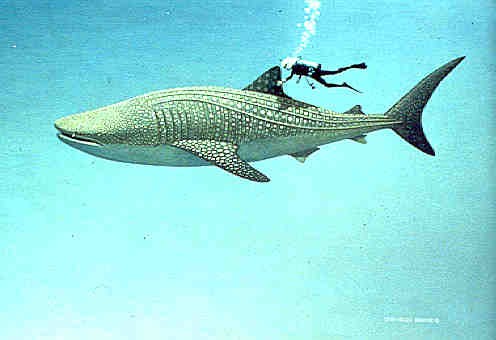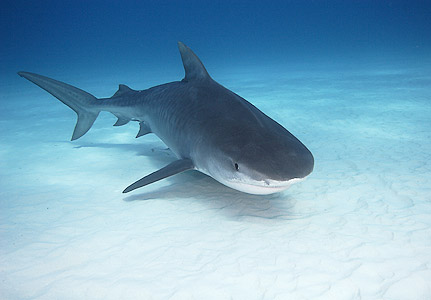- Biodiversity refers to the number of different species in a given area. The Gulf of Mexico has a high level of biodiversity. Its warm waters and diverse habitats are home to thousands of marine species.
- In 2009, scientists listed 15,419 species living in the Gulf of Mexico.
- Biodiversity is often used as a measure of ecosystem health. The more species present in an ecosystem, the healthier it is.
- Biodiversity is typically higher in warm regions of the world.
- The organisms that call the Gulf of Mexico home range from microscopic to gigantic.
- Karenia brevis, the organism responsible for Florida Red Tide, is so small you need a microscope to see it.
- Whale sharks, on the other hand, roam the deep waters of the Gulf of Mexico and can grow up to 40 feet long and weigh 80,000 lbs.

The decaying leaves of mangrove trees supply energy to entire ecosystems. Mangroves are unique for their ability to withstand inundation (flooding) by salt water. The red mangroves pictured here exclude salt using filters at the base of their roots. Black and white mangroves excrete salt through special glands located on their leaves.
- Each unique organism plays an important role in its ecosystem.
- Mangroves, coastal trees that are adapted to life in saltwater, drop leaves into shallow bays and estuaries. The leaves provide food for decomposers – organisms that consume dead matter in a process called decay. This provides energy and forms the basis for an entire ecosystem.

The decaying leaves of mangrove trees supply energy to entire ecosystems. Mangroves are unique for their ability to withstand inundation (flooding) by salt water. The red mangroves pictured here exclude salt using filters at the base of their roots. Black and white mangroves excrete salt through special glands located on their leaves.
- Bull sharks are an apex predator – meaning they are at the top of the food web. By consuming large quantities of fish, they regulate the population size of many smaller species.
- When green sea turtles graze on seagrasses, they promote new growth and prevent the seagrasses from developing diseases and parasites.
- When biodiversity is lost, ecosystems are thrown off balance and sometimes suffer serious consequences. When a coral reef is destroyed, all of the creatures that inhabit it are also harmed.
- When a species is eradicated, it is called extinction. Extinction often occurs due to loss of habitat. Extinction decreases biodiversity.
- When a species is in danger of extinction, it is called an endangered species.
- Threats to biodiversity include habitat loss, invasive species, and climate change.
- Invasive species are species that are introduced to an ecosystem in which they are not naturally found. They often take over the roles of naturally-occurring species and damage the balance of the ecosystem.
- It is important to protect and preserve biodiversity for a number of reasons.
- Biodiversity provides the natural resources that we depend on for our daily lives – thanks to biodiversity we have a wide range of food, products, and medicines.
- The rich biodiversity in the Gulf of Mexico attracts many tourists to the area, which supports local economies.
- A loss of species can have cascading effects on the entire ecosystem, and these effects can even spill into other ecosystems.
- There is also an inherent value in protecting species for the sake of keeping them on Earth.
Review Questions
- What is biodiversity?
- Describe the biodiversity in the Gulf of Mexico.
- What are some of the risks to biodiversity?
- Why is it important to preserve biodiversity?
Glossary
Apex Predator: A species at the top of the food web.
Biodiversity: The total number of species in an area.
Decomposer: An organism that consumes dead or decaying matter.
Endangered: At high risk of becoming extinct.
Extinct: No longer in existence.
Florida Red Tide: A harmful algal bloom that is the result of an accumulation of the microalgae Karenia Brevis.
Invasive Species: A species that does not occur naturally in a specific area but has been introduced.
Karenia Brevis: The microalgae responsible for the occurrence of Florida Red Tide; a solitary dinoflagellate that releases brevetoxins.
Mangrove: A coastal tree that is adapted to saltwater; provides important nursery habitat for many juvenile fish species.
Natural Resource: A naturally occurring material that is valuable to people and/ or wildlife.



